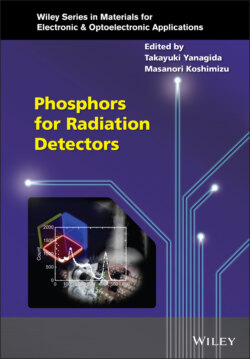Читать книгу Phosphors for Radiation Detectors - Группа авторов - Страница 15
1.2 Interactions of Ionizing Radiation with Matter
ОглавлениеInteraction probabilities of ionizing radiation depend on the species of ionizing radiation and matter under investigation. Figure 1.2 demonstrates a very common intuitive illustration of the interaction of ionizing radiation with matter. Although there are numerous species of ionizing radiations, the species included in Figure 1.2 are the most common.
Figure 1.2 Interaction of typical ionizing radiations with matter.
α‐rays (He nucleus) are common charged particle and have a high interaction probability with many materials, and a thin sheet of paper is enough to absorb these rays. In practical applications, a thin plate with a thickness of a few to several tens of μm scintillators are used as α‐ray detectors, and the most common scintillator for this use is Ag‐doped ZnS [10]. The weak point of the conventional Ag‐doped ZnS powder is poor energy resolution without a clear full‐energy deposited peak in pulse height spectrum. Generally, experimental environments of α‐ray detection contain so much X‐ and γ‐ray background, that detectors with Ag‐doped ZnS have difficulty in discriminating the level of signal and noise. In order to solve this problem, some new approaches were recently proposed [11, 12].
β‐rays are electrons that have higher penetrative power than α‐rays, but they can be absorbed by thin metals such as aluminum plate. For β‐rays detection, organic (plastic or liquid) scintillators are used [13], and organic scintillators are described in Chapter 2. In addition to organic scintillators, some inorganic scintillators are used by the electron detector in scanning electron microscopes (SEM) [14]. In β‐ray detectors, a fast response (rise and decay times) is often required. Because charged particles such as α‐ and β‐rays are easily stopped by detector components, dosimeters for these particles are not common. Recently, the muon has been used for the non‐destructive study of both artificial and natural objects [15], and plastic scintillators are used for muon detectors.
High energy photons, such as X‐ and γ‐rays, are the most useful ionizing radiation in practical applications, and one of their characteristics is a high penetrative power. In order to absorb X‐ and γ‐rays efficiently, we must prepare enough large and heavy materials such as Pb and Fe block. Generally, we use the density (ρ) and the effective atomic number (Zeff) to evaluate the detection efficiency of X‐ and γ‐ray detectors. Here, Zeff is defined as
(1.1)
where wi is the weight ratio of the i‐th element of the detector material, and Zi is the atomic number (Z) of the i‐th element. The power in the formula depends on its application. In the case of the scintillation detector, generally we evaluate the detection efficiency by Zeff4, since the interaction probability of the photoelectric absorption event is proportional to ~ρ Zeff4, while we use the power of ~3 (sometimes 2.94) for individual dosimeter applications. It must be noted that Zeff in scintillator and dosimeter fields can vary. In scintillators for X‐ and γ‐ray detectors, generally, high ρ and Zeff are preferable. On the other hand, light materials with Zeff close to 7.1 are preferable for individual dosimeter applications, because Zeff of the human body is around 7.
In the case of neutrons, the tendency is largely that of differently charged particles and photons. Although neutrons have a high penetrative power when applied to paper, thin metal plate, and heavy block, they have a high interaction probability with H, so H2O is an effective material to interact with neutrons. In neutrons, some specific elements, such as H, 3He, 6Li, and 10B, have a high interaction probability, and in order to detect neutrons efficiently, and detector materials should contain these elements. Especially, a 3He‐filled gas proportional counter is the standard detector for thermal neutron detectors.
